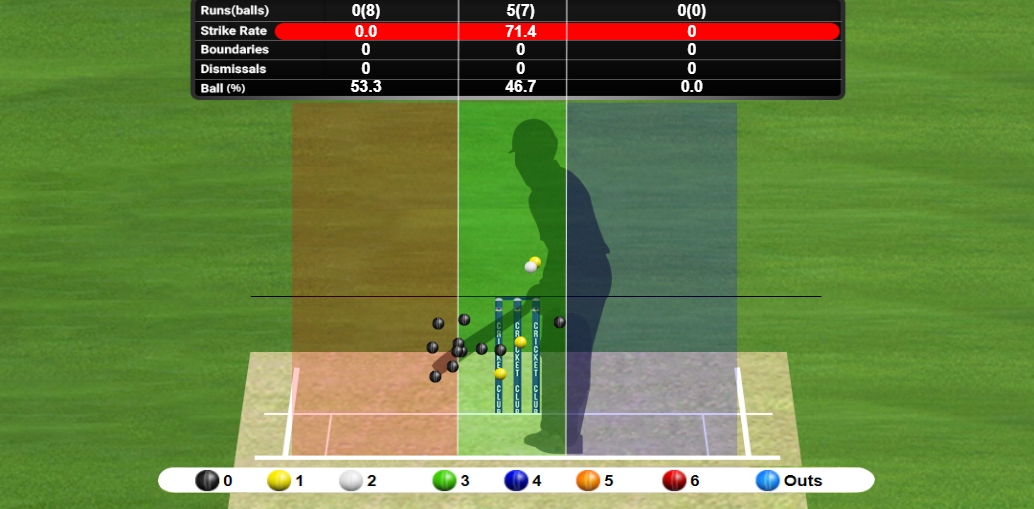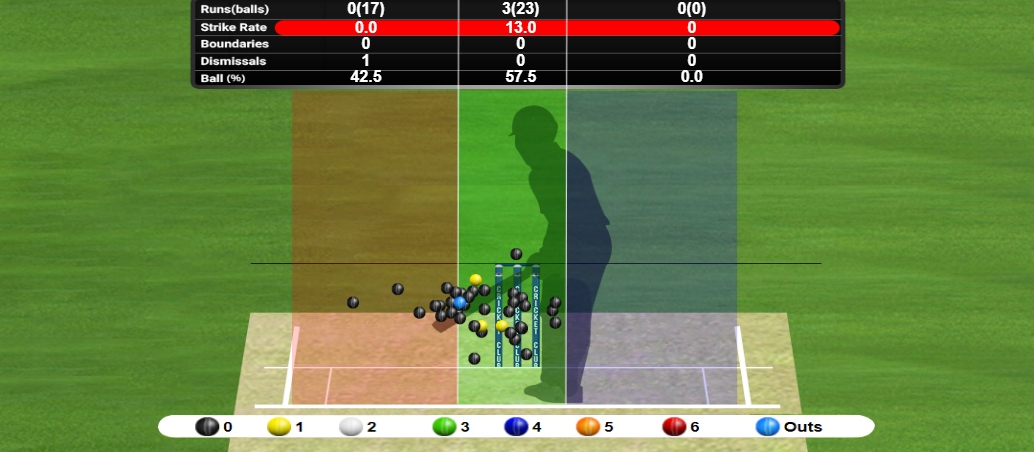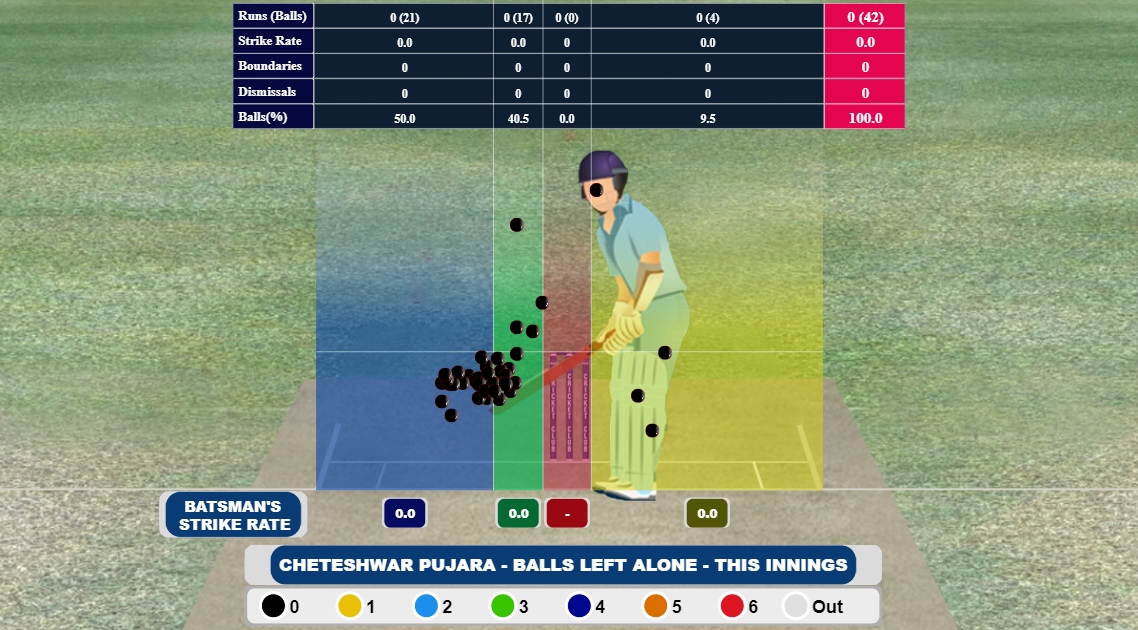 OPINION
OPINIONKL Rahul re-lives flashback of 2018
He certainly did not look like a walking duck. Nor did he perish within the first 20 balls of his innings. His technique wasn’t loose, either. But KL Rahul, today, looked as uncomfortable as he has all series. Was it the loose drive he played in the first over of the first innings that put doubts in his mind? Possibly. But for 54 balls, the right-hander was at the mercy of the England seamers.
How the English quicks tamed Rahul was interesting. There was a conscious ploy from the hosts, in particular Ollie Robinson, to target the opener’s stumps and pads once he started showcasing the same discipline outside off-stump that he did in the first two Tests.
England to Rahul - first 15 balls

England to Rahul - last 39 balls

In all Robinson bowled 32 balls to Rahul, conceding just 6 runs, but an astonishing 26 of them (81.25%) came into the right-hander. This figure was a significant rise from the first two Tests, where only 61.6% of Robinson’s deliveries to Rahul came into the batsman.
Rahul’s control percentage to these deliveries on Day 3 was a mere 61.5%, and on multiple instances he was pinned in front of the stumps, with DRS coming to his rescue on one occasion after the on-field umpire ruled him out.
What this ended up doing was make him vulnerable to the ‘surprise’ delivery leaving him. Once more deliveries began angling in, Rahul also started ‘leaving’ fewer balls.
While in the first 34 balls of his innings Rahul left 41% of the deliveries, the last 20 balls saw him leave just 30%. As it turned out, he was undone by an Overton ball that moved away (although the bowler smartly went wide of the crease). Looking back, the right-hander would probably have wished that he’d left the ball alone - despite the angle, he fended at a delivery considerably outside off-stump.
Ringing alarm bells would be premature, but Rahul will know that England would be encouraged by what they witnessed today. For the first time this series, he looked conquerable. If his hand gestures of the wrist position for an inswinger while sitting in the dressing room is anything to go by, thoughts of the incoming ball did not leave his mind even after getting out.
With two Tests remaining, only time will tell whether the episode today will prove to be important in the context of the series.
The long term ramifications of Sam Curran’s workload
Forget the fact that Curran conceded nearly five runs per over when all his teammates hovered around the 2.00 mark. Forget the fact that he looked insipid, non-threatening and pushed his bowling average for the series beyond 75. The biggest problem for England is that Curran is barely bowling, for it could have long-term ramifications.
Across five innings this series, Curran has sent down 74 overs. In other words, he’s bowled an average of 88.8 balls per innings. Among bowlers who have played all three Tests this series, no one has bowled fewer.
Curran being underbowled - and understandably so, his bowling has lacked incision - has meant that Root has had to impose a significantly higher workload on both Anderson and Robinson than he would have liked. In a way England got lucky that India’s first innings at Headingley lasted only 40.4 overs, but prior to this Test, no one had bowled more overs than Anderson (82.3) and Robinson (80.5).
Why this matters is because the turnaround between Tests, from hereon, is virtually non-existent. Were England full strength, they might have pondered resting Anderson - and possibly Robinson too - knowing that they could still field a competent attack that could hurt India.
But with Broad, Archer and Stone all injured, and with there still being uncertainty over the availability of Wood and Woakes, they are currently in a position where they can ill-afford to lose the services of Anderson and Robinson.
Pulling through five Tests in a row is a next-to-impossible task in itself for a 39-year-old, nevermind the fact that Anderson has not done so since 2018. By imposing unnecessary, extra workload on the veteran, England are flirting with danger - big time.
Root needs more from his fourth bowler if England are to win this series. Whether Curran is the right man is something for him and coach Chris Silverwood to examine. The fear, though, is that it might be too late already.
Pujara turns back the clock - albeit with a twist
That opinion piece you wrote about why India need to look beyond Pujara - yeah, you can go ahead and delete that. The listicle in your drafts exploring who can bat at #3 for India in the fourth and fifth Test? You can delete that too. Like it or not, Pujara is staying. And in a way, through his knock today, the 33-year-old has deservedly bought himself more time.
At Lord’s, Pujara, though he scored 45, did not inspire too much confidence, and his 1(9) in the first innings at Headingley seemed to confirm suspicion that he was not really back to form. Today, however, the Saurashtra batsman arguably batted as well as he has outside Asia in three years and more.
Unlike any of his previous outings, Pujara, today, was gifted freebies in plenty by the English bowlers. All bowlers, Anderson included, strayed straight, and he took full toll of it, racing to 14 off his first 13 balls (!!). This helped him shrug nerves.
But almost uncharacteristically, he piggybacked off that early confidence and continued batting with intent. This you don’t see often with Pujara. So ‘uncharacteristic’ was his knock today - in a good way, of course - that he pulled aerially to bring up his fifty, his fastest ever in a SENA country.
It was not just the attacking strokes that inspired confidence, though. Out caught 4/4 times this series, prior to today, Pujara left admirably well. His off-stump awareness was Rohit-esque, you could say.

The graphic above shows how well Pujara left, but here’s a statistic that shows how much he left: across the first two Tests, the right-hander left just 19.4% of the deliveries he faced. Today, he left alone 42.9% of the first 50 balls he faced. Indeed there were moments when the bad habit to poke the bat resurfaced, but, for the most part, he restrained his urge to do so.
He also grew with confidence as his innings progressed; the more he batted, the more he looked assured. In the first 20 balls, Pujara’s false shot percentage read 20%. Between balls 31-90, this number reduced to 13.3. After the 90-ball mark, the right-hander played a mere 11.9% false shots. A sign of the old Pujara slowly emerging out, perhaps?
Crazy as it sounds, it is still hard to jump to conclusions. There is still no guarantee that Pujara will carry this form forward into the next Test. But runs were the need of the hour, and he delivered. Today, Pujara showed why he has 89 Tests under his belt.